SEC595: Applied Data Science and AI/Machine Learning for Cybersecurity Professionals


Experience SANS training through course previews.
Learn MoreLet us help.
Contact usBecome a member for instant access to our free resources.
Sign UpWe're here to help.
Contact Us
Apply your credits to renew your certifications
Attend a live, instructor-led class at a location near you or remotely, or train on your time over 4 months
Course material is geared for cyber security professionals with hands-on experience
Apply what you learn with hands-on exercises and labs
Stop reactive firefighting. Learn to build SOC operations from the ground up—with the right people, threat-focused detection, battle-tested incident response, and metrics that drive real results.
There are so many [organizations] that seem to be trying to reinvent the wheel. All they need to do is invest in this course for real world, actionable information that can put them on a solid path toward building, staffing, and leading their own SOC.
LDR551 is a transformative training program designed for senior security leaders who demand more than traditional Security Operations Center (SOC) management. This executive-level course equips technology leaders with advanced intelligence-driven methodologies to proactively defend against sophisticated threat landscapes. Navigate complex cyber environments with a strategic approach that aligns security operations directly with high-stakes organizational objectives.
Key executive outcomes include designing resilient defense strategies tailored to your enterprise's unique risk profile and transforming SOC capabilities from reactive to proactive. Additionally, you'll integrate cyber leadership principles with tactical threat management, while gaining hands-on experience through 19 immersive labs and the Cyber42 leadership simulation game.


John is a Senior SANS Instructor and SOC consultant, author of SEC450 and LDR551. With deep SOC leadership experience, GIAC certifications, and hands-on labs, he equips cyber defenders with the skills to hunt, detect, and lead resilient operations.
Read more about John Hubbard

Mark Orlando brings extensive cybersecurity leadership experience from the Pentagon, White House, and Fortune 500 sectors. As Bionic Cyber's CEO, he's a respected security operations expert with military and academic credentials.
Read more about Mark OrlandoExplore the course syllabus below to view the full range of topics covered in LDR551: Building and Leading Security Operations Centers.
Section 1 introduces the core mission and foundational models of a modern SOC, establishing the strategic and operational context for effective leadership.
Section 2 of LDR551 focuses on expanding our understanding of attacker tactics, techniques, and procedures and how we might identify them in our environment.
Section 3 of LDR551 is all about building and improving your threat detection capability.
From toolsets to proven frameworks to tips and tricks learned in countless real-world scenarios, section four covers the full response cycle, from preparation to identification to containment, eradication, and recovery, for operations managers.
The fifth and final section of LDR551 is all about measuring and improving security operations.
Lead operational teams from the point of view of an adversary in order to protect your most sensitive assets.
Explore learning pathResponsible for conducting software and systems engineering and software systems research to develop new capabilities with fully integrated cybersecurity. Conducts comprehensive technology research to evaluate potential vulnerabilities in cyberspace systems.
Explore learning pathDaily focus is on the leadership of technical teams. Includes titles such as Manager, Information Security Specialist, and Program/Project Leader.
Explore learning pathThis job, which may have varying titles depending on the organization, is often characterized by the breadth of tasks and knowledge required. The all-around defender and Blue Teamer is the person who may be a primary security contact for a small organization, and must deal with engineering and architecture, incident triage and response, security tool administration and more.
Explore learning pathSecurity Operations Center (SOC) managers bridge the gap between business processes and the highly technical work that goes on in the SOC. They direct SOC operations and are responsible for hiring and training, creating and executing cybersecurity strategy, and leading the company’s response to major security threats.
Explore learning pathResponsible for developing and maintaining business, systems, and information processes to support enterprise mission needs. Develops technology rules and requirements that describe baseline and target architectures.
Explore learning pathResponsible for the secure design, development, and testing of systems and the evaluation of system security throughout the systems development life cycle.
Explore learning pathThis role conducts supervises, manages and leads cybersecurity teams and work. Find the SANS courses that map to the Leadership SCyWF Work Role.
Explore learning pathAdd a GIAC certification attempt and receive free two practice tests. View pricing in the info icons below.
When purchasing a live instructor-led class, add an additional 4 months of online access after your course. View pricing in the info icons below.
This course immediately expands your toolkit to problem solve in NOSC operations management.
Great content. Covers a lot of ground and exposed me to a lot of new concepts and ideas, and ties content to current real-world examples.
It has covered a lot of great information that can be applied anywhere when implementing or improving a SOC.
I would recommend this course to anyone running a security operations team. I’d further recommend it to more experienced analysts so they can begin to see the bigger picture.

Get feedback from the world’s best cybersecurity experts and instructors

Choose how you want to learn - online, on demand, or at our live in-person training events

Get access to our range of industry-leading courses and resources